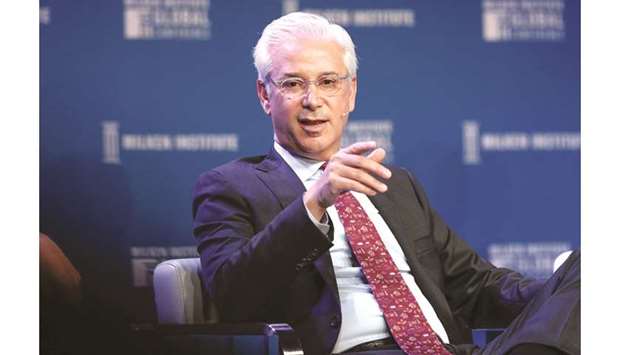Wells Fargo & Co’s long awaited next leader, Charlie Scharf, formally took over yesterday with a fairly straightforward mandate: Finish what three predecessors couldn’t.
The bank’s scandals and frayed relations with much of Washington have dragged on the stock for more than three years while outlasting two chief executive officers and an interim boss. The stock has barely moved since the ordeal began in September 2016, while the 24-company KBW Bank Index has climbed 40%.
For Scharf that means there’s a risk of failure, but also a great opportunity if he gets it right. The mere announcement of his appointment last month pushed Wells Fargo up almost 4% as investors bet an outsider would succeed in finishing the firm’s overhaul.
The new CEO won’t get started in San Francisco, where the bank is headquartered. Nor is he making his first moves in New York, where he’ll be based. Scharf was expected to spend the first day of his tenure in St Louis, one of Wells Fargo’s Midwest hubs, where was scheduled to meet with clients and employees later yesterday.
Here are his biggest challenges:
Investigations
Wells Fargo faces a number of ongoing probes, most notably the US Department of Justice and the Securities and Exchange Commission looking into its sales practices. That will likely mean a big-ticket settlement in Scharf’s early days.
The firm said earlier this year that it’s in settlement talks with the two agencies. Wells Fargo took a $1.6bn legal charge in the third quarter, without specifying what prompted the expense. Chief financial officer John Shrewsberry only said it was related to the “largest of the lingering issues relating to sales practices.”
There are also more than a dozen other inquiries, including investigations into how the firm procured low-income housing tax credits and pricing inconsistencies in its foreign-exchange business.
Wells Fargo has 14 outstanding consent orders with its regulators, most notably a growth cap from the Federal Reserve. The Fed has banned the firm from boosting assets beyond their level at the end of 2017 until it fixes its missteps — a big sticking point for investors.
The Office of the Comptroller of the Currency has an order in place requiring wholesale changes to Wells Fargo’s governance and risk management. And regulators haven’t been shy about publicly expressing their dissatisfaction with progress so far.
It’s up to Scharf to convince them the firm has a grasp on its operations and proper processes in place.
Wells Fargo in recent years has accomplished a rarity in Washington: uniting politicians across the aisle.
Elizabeth Warren, who’s contending for the Democratic nomination for president in 2020, has been among the bank’s most vocal critics. Maxine Waters, a California congresswoman who chairs the House Financial Services Committee, is also near the top of that list. And President Donald Trump piled on with a tweet in 2017, saying that fines against Wells Fargo “will be pursued and, if anything, substantially increased.”
Congress called former CEO Tim Sloan to testify multiple times during his 2 1/2-year tenure, and Scharf can expect the same treatment. Lucky for him, he’s had practice — as CEO of Bank of New York Mellon Corp, he was among leaders of the biggest US banks who participated in a House Financial Services Committee hearing earlier this year.
Technology
Wells Fargo’s technology has been a focal point for regulators, especially after a high-profile, days-long failure of one of the bank’s data centres in February. Scharf will be charged with overhauling internal systems and moving Wells Fargo into the future.
For the lender’s board of directors, part of the new CEO’s appeal may be his experience doing just that in a prior role. At Visa Inc, Scharf opened up the network to emerging payment technologies, which involved collaborating with giants like Apple Inc and Google, giving startups access to Visa’s systems, and investing in smaller firms. At the time, he said Visa had to “think and act much more like a technology company than we have before.”
Productivity
Wells Fargo employs more people than any other US bank, with a workforce of 261,400 as of September 30.
Its revenue per employee has dropped below most major peers, and Sloan in 2018 announced plans to cut staff by as much as 10% within three years. A year later, headcount has stayed roughly flat.
For Scharf, who’s gained a reputation as a cost-cutter, slashing headcount is an opportunity to drive up earnings.

Charles Scharf, the new CEO of Wells Fargo, speaks at a conference in Beverly Hills, California. Wells Fargo’s scandals and frayed relations with much of Washington have dragged on the stock for more than three years while outlasting two CEOs and an interim boss. The stock has barely moved since the ordeal began in September 2016, while the 24-company KBW Bank Index has climbed 40%. For Scharf that means there’s a risk of failure, but also a great opportunity if he gets it right.
